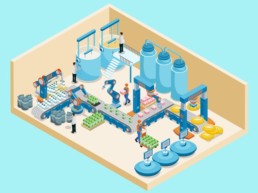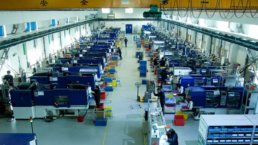IIT Kharagpur develops novel Industry 4.0 tech for advanced manufacturing sector
IIT Kharagpur has developed a novel Industry 4.0 technology for remotely controlled factory operations and real-time quality correction during industrial production in India’s advanced manufacturing sector, the Department of Science and Technology said on Friday. The present innovation upgraded the industrial process of friction stir welding to a multi-sensory system of Industry 4.0.
The innovative technology developed by Suriya K Pal, professor in-charge at the Centre of Excellence in Advanced Manufacturing Technology, IIT –Kharagpur, in association with TCS, will acquire real-time information about the welding process through multiple sensors and ,enable online control of weld quality by means of cloud-based communication with the friction stir welding machine. “Welding is at the heart of any industrial operations. If we can improve the weld quality in real-time during batch production we can reduce rejections in post-production sample checks,” Pal said. Explaining the new technology, he said, “Our multiple sensor process involves various signal processing and machine learning techniques to predict the ultimate tensile strength of the weld joint is fabricated.”
This technology is connected with a vast experimental knowledge base to conform to a standard system and prediction of the weld joint strength, he noted. “Any defect identified during the monitoring procedure is corrected in real-time by sending modified parameters to the machine thus ensuring standardised quality of the process,” he said. The concept of this technology can further be evolved for real-time control of other industrial processes and such work will be carried at the centre with other industrial partners soon, Pal added.
“It (the technology) has not only set the course for remotely controlled operations in the Indian industrial sector but has also enabled real-time quality check and correction during the production process.
“This will make it possible for industrial houses to achieve standardised quality goals throughout the production process and reduce rejection hence lowering the cost of production,” the DST said in a statement.
Digital manufacturing could be the next big opportunity for India
India has the potential to become a global manufacturing hub if it speeds up the adoption of technology on the shopfloor, according to a new paper by foreign policy think-tank Gateway House.
The country could be a beneficiary of the global decoupling from China as companies start to move their manufacturing operations out and need a new supply chain partner, it said.
“India needs to look at digital manufacturing and go beyond industry 4.0 – it needs accelerated manufacturing, but needs to create jobs as well,” said Manjeet Kriplani, executive director, Gateway House. She said Indian software firms and startups would have an important role to play in helping domestic enterprises make this transition.
Digital manufacturing goes beyond just Industry 4.0, blending manufacturing with IT, including artificial intelligence, virtual reality and the Internet of Things. Already, the United States and Japan have called to move manufacturing out of China, primarily on security concerns.
In July, the Japanese government said it would pay companies to move their manufacturing operations out of China, putting aside over $500 million for this. Indian enterprises need to build strong digital manufacturing capabilities in order to take advantage of this situation, the think-tank said.
This can be a great opportunity for India, but things are moving slowly because of the Covid-19 pandemic, said Rajan Navani, managing director, Jetline Group.
“We are a source of tech talent to the world and can make the most of this opportunity. But Indian industry needs to invest much more than what they currently are,” said Navani, who is also Chairman of CII’s India @75 initiative.
Most of the automation and tech initiatives in India are driven by multinationals, and by the time Indian companies do invest, it is more about playing catch up. The pandemic is driving faster adoption of digital technologies in India, said Ashish Gaikwad, managing director, Honeywell Automation India.
With changing customer demands, quality parameters, and environment and safety regulations, the manufacturing sector will adopt automation and Industry 4.0 much faster, he said.
“As we slowly embrace a ‘new normal’, we are ready to serve our customers’ needs to help provide a safe, secure, and productive work environment with our mobility solutions. Across our businesses, we have a suite of products and solutions that enable remote operations, worker safety, and rapid adjustment to the post-Covid-19 world,” said Gaikwad.
The company is currently implementing various solutions in pharma companies to provide complete visibility of essential manufacturing processes and help speed up time to market.
Chizel, a startup that offers manufacturing as a service, has seen a sharp spike in international inquiries after the early days of the pandemic.
“There is demand from European and Australian companies that were earlier sourcing parts from China. These are mainly heavy engineering companies and equipment manufacturers,” said Yash Rane, founder, Chizel, which provides an online platform for customers to upload their drawings. Chizel then manufactures them through its network of job shops.
The challenge, said Rane, is convincing them of the quality of the end-product. Several of these companies have worked with Indian companies before and have concerns over quality even though it is a cost competitive option. Small and medium businesses, often an important part of the supply chain, are also realising the importance of technology.
A recent study by Cloud firm Digital Ocean found that demand for digital services by SMEs in India far outpaces demand in the United States. Respondents in India (in businesses with under 1,000 employees) reported greater spending on IT security and the cloud, and higher demand for cloud services in the next 3-6 months.
Indian businesses also need to increase focus on sustainability. Treeni Sustainability Solutions provides enterprises sustainable supply chain management solutions. “Adopting sustainable supply chain practices is another factor that would help enterprises attract global customers as they look at reducing the supply chain dependence on China,” said Ankush Patel, CEO, Treeni.
Even as some Indian businesses are making the transition and adopting more digital manufacturing practices, experts pointed out that it needs to happen at a wider scale for the country to truly benefit.
Wanted: A Joint Secretary for 'digital drive' at the Ministry of MSME
JUNE 09, 2021 :- ShopWorx , a cloud-based IOT solution with "MSME First" Agenda
The times are tough. Small businesses are faltering in India, and in a recent survey by Dun and Bradstreet, over two-thirds of them reported that it would take them a year to recover to pre-COVID-19 demand levels.
In the survey, the top three factors reported that would help revival were access to credit, better marketing support, and technology adoption. In fact, through digitisation, technology is the game-changer, enabling more accessible credit through Fintechs, increasing the reach of business through e-commerce platforms, and improving throughput owing to IoT solutions.
Digitalisation has tremendous potential in speeding up the MSME growth. These concerns are addressed by Pune-based startups such as ShopWorx with cloud-based IoT solutions built on the ‘MSME First’ agenda.
e-Gemba Meetings: How They Can Change the Way You Look at Data!
Gemba is a Japanese concept that involves site visits to understand outlying problems with your manufacturing process. Using Gemba, senior management can better understand why the manufacturing plant might be facing efficiency and productivity issues. They can be guided by the plant manager during their Gemba walk or choose to take a walk themselves and interact with the workers on the shop floor. A Gemba walk is meant for employees who are higher up in the management hierarchy to interact with the workers on the floor. Furthermore, it allows the senior management to further understand the manufacturing process. This understanding enables them to gain insight into different steps of product development and ask the right questions when problems appear.
The Traditional Gemba Approach
However, the traditional Gemba approach is more centred on what the managers see with their own eyes. The role of data in a Gemba walk is minimal, and hence the decisions made on the basis of a Gemba walk can often not be backed by the data generated at the shop floor. Additionally, the Gemba walk can often lead to decisions skewed in favour of workers and detrimental to the company. If the Gemba walk is periodic, it is often possible to ‘rig’ the walk by ensuring that the plant works fine during the duration of the walk. Since the walk happens during the plant’s normal working hours, the time available for workers to answer questions is limited. The walk can also disrupt the working of the manufacturing process. A Gemba walk can also potentially have a narrow view and not be able to look at all the issues that the plant is facing.
e-Gemba
Based on the above issues and challenges of traditional Gemba walks, the concept of e-Gemba has been developed. At its core, e-Gemba is a data-driven Gemba approach that consolidates what the manager observes on the shop floor with the data that the shop floor provides. Among the major prerequisites for e-Gemba is the digital transformation of the shop floor. The concept of e-Gemba can be a major component of industry 4.0. Especially in manufacturing facilities where end-to-end manufacturing is involved, e-Gemba can provide actionable and valuable insights into the bottlenecks of your manufacturing process and help you address these challenges through data.
There are several ways that e-Gemba is currently performed. Since there is great emphasis on the collection of data, this is done using tablets, cameras, or even computer vision capabilities. Additionally, augmented reality plays a huge role in performing e-Gemba walks since it helps managers survey the manufacturing process while data collection occurs concurrently.
Many advantages come with e-Gemba. Here is a brief overview of just a few of them.
- Reduction in Bias: As noted above, traditional Gemba can potentially be biased one way or another and be detrimental to the company’s bottom line. Since the manager will generally be taking the subjective opinion of workers, it is possible that decisions taken after the Gemba walk can go excessively in workers’ favour. However, Gemba walks that are based on data allow you to maintain a balance between the workers and the bottom line of your company. Using advanced data analytics tools, you can preempt the impact that a particular decision will have on your bottom line.
- Reduced Resistance to Change: Among the main advantages of traditional Gemba is that workers are accorded respect by the management. They are made major stakeholders in the decision-making process, and hence their resistance to changes that you introduce is minimized. However, changes made in workers’ favour might meet resistance at the senior management level. This can be reduced by using data to back your decisions, satisfying the workers and the management.
- Transparency: Since traditional Gemba is more of a subjective method, it is hard to maintain transparency in business decision making when using it. When data is involved, a greater amount of objectivity is brought to decision-making, and all stakeholders’ concerns are addressed while maintaining the transparency of your business data. Through the real-time insights that this data provides, it is possible to indulge in continuous improvement of your manufacturing processes without bringing about radical changes that can disrupt your manufacturing process.
Improved Bottom Line Through e-Gemba
There is no doubt that the initial cost of shop-floor digitization for creating a smart factory can be significant. However, these costs can be quickly recouped through the improvements you make in the company’s bottom line. Among the most significant advantages of using data alongside Gemba is that the impact of changes on the bottom line can be forecast and significant losses can be reduced or avoided altogether.
Conclusion
The concept of e-Gemba is capable of bringing about a major change in how manufacturing decisions are made. It combines data-driven insight with what is observed on the shop floor to address the concerns of all involved in the manufacturing process. It also makes your decisions more justifiable and improves the transparency in your business decision making. These factors combine to result in a better bottom line.
Shopworx provides end-to-end solutions for shop floor monitoring. Our software has become the go-to solution for improving shop floor productivity. Contact us to book a demo.
Emerge as a manufacturing leader, by simply following these steps
How Manufacturing Leaders Use Digitization to Drive Their Business
The manufacturing sector has been undergoing changes in the past few years. The number of competitors in each product category of the manufacturing industry has been growing. Each company aims to capture a niche and build a rigid and loyal customer base. There have also been several disruptors who have aimed to change the way that the manufacturing industry works and have captured large swathes of market share. Being the dynamic industry that manufacturing is, the processes and technologies being used by it are changing continuously.
Digital transformation in the manufacturing industry has been among the major trends observed over the last decade. All manufacturing leaders have implemented concepts of Industry 4.0 to make themselves more future-ready and gain an edge over their direct competitors. By enabling end-to-end manufacturing, digitization ensures that the efficiency of the manufacturing process increases. Whether it is large manufacturers or new companies aiming to emerge as manufacturing leaders, digital transformation is among the most critical steps to take with the future in mind.
Advantages of Global Sourcing
With an increase in globalization, global manufacturing has also received a boost. There are several advantages that global manufacturing, driven by the digitization of manufacturing, provides over traditional, local methods. Here is a look at the primary advantages of global manufacturing.
- Better Value: With global manufacturing, you will likely receive much better value for the money you invest in developing your products. This is primarily because even if you include the charges of customs, import, and export, several countries in the world can provide you services at rates that are a fraction of the costs you will incur locally. Especially in the APAC region, countries such as Malaysia, China, India, and Indonesia have emerged as manufacturing hubs with low labor and land costs, translating into high returns on investment.
- Production Capacity: If the location to which you are outsourcing your manufacturing activities has low land costs, it is possible to build greater production capacity at these locations. With the same amount of investment, it becomes easier for you to generate a greater product volume at the same cost. Especially if you are going through a phase of high demand, outsourcing your product can help you achieve a competitive advantage as well as competitive pricing for your product.
- Product Quality: There are several factors that your product quality can depend upon. The decision to outsource can backfire most frequently in the form of poor product quality. However, if you set up a smart factory with shop floor digitization in the country you are outsourcing your manufacturing process to, you can minutely monitor the quality of the products that are being created. The power of digitization ensures that there is now a minimal difference remaining between local and international manufacturing locations.
- New Skills and Resources: Outsourcing your production activity can provide you with the opportunity to tap into new skills that might be available with the workforce of the other country. Additionally, resources which might not be available locally to you might be available more easily to your outsourcing partner by virtue of location. This helps you build a highly efficient team and leads to a win-win situation for you and your outsourcing partner.
Export Quality Suppliers and Orders
The outsourcing of manufacturing is not a new concept and has been carried out for more than half a century. However, with time, the processes involved have become outdated, and the quality parameters that manufacturers are achieving from them are not in line with the expectations of the times.
This is the reason that global manufacturing has developed a need for digitization. Digitization in global manufacturing can help manufacturing companies improve the quality of the products outsourced and monitor the returns on investment that the introduction of new tools is making.
The digital transformation of manufacturing is essential if you are looking to build a high-quality portfolio. Digitization also helps you achieve improved visibility of every step in your manufacturing process by providing real-time insights. These timely actionable insights can help you in making the correct, data-backed decisions for your company. Through better quality for end customers, digitization can improve your clients’ trust in your organization and result in greater revenues.
Conclusion
Emerging as a manufacturing leader is not a one-dimensional process. You need to aim to build better products at lower costs while maintaining customer satisfaction and loyalty. The greater the extent to which you digitize every level of your shop floor, the greater the insights you will gain through the data generated by this digitization. This, in turn, will help you optimize and improve your manufacturing process and maximize profits.
ShopWorx helps you digitize your manufacturing facilities while causing minimal disruption to your current processes. Opt for ShopWorx to transform your shop floor with the latest digital technology!
Improve your Just In Time delivery and reduce inventory costs with smart factory solutions
High inventory costs can pull any white good and automotive player out of the competition. Follow these smart factory solutions to refine your JIT delivery and curb your inventory costs surge.
The white goods and automotive industries cannot afford to thrive with outdated JIT (just-in-time) delivery systems. They need to invest in advanced manufacturing technologies to gain an edge over the competition. And this is where the concept of a smart factory comes into the picture. It boosts manufacturing efficiency and offers countless cost-combating opportunities.
The smart factory is a digitised system that collects and shares information through connected gadgets, devices, and production systems. White goods and automotive industries can use this data for digital transformation, self-optimisation, and streamlining performance. It also helps in addressing supply chain issues, refining manufacturing processes, and reciprocating to new demands.
Keep reading on as we outline:
- How JIT delivery helps in reducing inventory costs.
- What is the role of smart factory solutions in improving JIT strategies and reducing inventory costs?
What is achieved with just-in-time delivery (directly proportional to cost)?
The right JIT delivery strategies can help in reducing warehouse costs, working capital requirement, manufacturing costs, and wastage.
- Reduces warehouse costs: Storing excessive raw material in the warehouse can add up to your expenses significantly. Going for TPS-Toyota Production System or JIT delivery is a great way to avert this situation and shrink your warehouse and storage costs.
- Reduce working capital requirement: JIT is all about taking only essential inventory for the manufacturing processes. Moreover, the fresh stock arrives only when the minimum re-order level is hit. This process plays a vital role in reducing working capital requirements in the business.
- Decreases manufacturing costs: JIT is a demand-pull inventory system that helps in managing effective supply chains. It also lowers the manufacturing costs and product costs of the factories. The result is an enhanced market share, improved visibility, and high profitability.
- Minimise wastage: The market demand remains fickle and volatile in white goods and the automobile manufacturing sector. Stocking surplus inventory might result in excess expired and unsold items. Timely actionable insights with JIT will not only help in reducing wastage but also eliminates overproduction.
- Right-first-time concept: JIT is a lean manufacturing technique that emphasises the right-first-time concept. It helps in minimising the cost of inspection and rework cost to a great extent.
How have smart factory solutions helped in just in time delivery and reduced costs?
Smart factories use a collaborative and fully integrated manufacturing approach to make systems more optimisable, adaptable and flexible. It has played a vital role in improving JIT delivery and reducing costs. Let us dive into the details:
Industry 4.0
- Industry 4.0 is an advanced technology that manages and optimises several aspects of the supply chain and manufacturing processes.
- That’s not all. It also allows you to access real-time data and perceptions to make faster and smarter decisions.
- Industry 4.0 has done a great job in improving JIT delivery systems, reducing downtime, and lowering inventory costs.
Industrial internet of things
- The ability to track, connect, automate, and analyse is crucial for success in the white goods and automotive industry.
- IIoT is the best performance monitoring solution that allows companies to use real-time data to predict system failures.
- It is a boon for production lines where a single fault in the machine can hamper workflow and incur huge cost.
- IIoT addresses maintenance issues and offers excellent improvement in operational efficiency.
- It also helps in streamlining the end-to-end manufacturing process.
Cloud computing
- Cloud computing played a significant role in autonomous driving, connected cars, shared mobility, digital manufacturing, and deeper customer insights.
- It is a shop-floor digitisation technology that enables smart factories to accumulate, process, and share real-time data with greater flexibility.
- The best part about cloud computing is that it allows you to upload a massive amount of data. It also prevents data loss risk to a greater extent.
Sensors
- Companies that want to experience the power of digitisation can go for smart sensors. It is a smart factory solution to improve your JIT delivery and reduce inventory costs.
- Smart sensors do an excellent job in data conversion and digital processing.
- Apart from processing, it can also transfer data to Cloud and other external devices.
Bottomline
So this was all about the shop factory and its role in improving just-in-time delivery and reducing inventory costs. Companies that aim to carve a niche in the industry should not miss a single opportunity to implement these solutions in their manufacturing systems.
Make sure you trust the best when it comes to introducing advanced manufacturing techniques into your business. ShopWorx is a leading name that is known to offer brilliant end-to-end smart factory solutions to its clients.
The highly efficient team of ShopWorx work towards introducing newer, faster, better, and cheaper technology on the manufacturing shop floor. So what are you waiting for? Connect today to discuss your requirements and utilise digital innovation to upgrade your supply chain efficiencies.
Why Is it Time to Digitize All the Manufacturing Shop Floors
Digitization has been seen as the future of manufacturing for several years now. More than a decade ago, enough technological progress had been made to enable medium and large enterprises to digitize all their shop floors. However, even in 2021, many manufacturers have chosen to stay away from digitization for various reasons.
As per a 2019 global study by ToolsGroup, 32% of manufacturing companies were still at the exploring stage of adopting digitization. A full quarter of all companies were at the evaluating stage. This means that at least 58% of companies had not yet started with the adoption of shop-floor digitization. Only 27% were executing digitization, while only 7% were at the stage where its benefits could be felt.
It emerges that the main reason why companies have chosen to stay away from digitization is that digital technologies can create disruption in the daily working of a company and lead to chaos and confusion. The cost of digitization is also a significant factor, with companies holding the belief that it is best suited for large companies only. This has created a large gap in digitization adoption between OEMs and small and medium-sized manufacturers.
Future Landscape of Digitization
Even with the evident gaps in digitization, the future landscape of digitization seems bright. There are several reasons firms are looking to adopt digitization, not the least of them being that the role of technology in manufacturing increases every year. It is likely that in the decades to come, a majority of manufacturing processes will have a digitized analog that is more efficient and provides better returns on investment. An investment in digitization is hence likely to lead to robust returns over the long term.
Why Adopt Digitization?
The primary reason for digitization not being adopted widely seems to be that the impact of digitization is only felt in the long term. There are several benefits of shop-floor digitization, some of which are listed below.
- Enhanced Operational Efficiency: Perhaps the most significant advantage of digital transformation is the improved efficiency of processes that it leads to. Digitization helps develop true end-to-end manufacturing, which is a significant part of the Industry 4.0 or smart factory concept. Enhanced operational efficiency is especially important in an era when competition across the manufacturing industry is increasing, and more prominent players seem to be capturing an ever-greater size of the market. It is only possible to retain your niche through the improved efficiency and cycle times that digitization brings. Once you have captured your niche, digitization also helps you determine better options for scaling and growing larger.
- Innovation: Digitization helps you in developing an intelligent factory system in which all repetitive tasks are automated. Such a system promotes innovation by its employees, managers, and workers. When workers do not have to perform repetitive tasks, they get a greater leeway to innovate and make existing processes much more robust. Digitization also helps companies innovate through data-driven decision making since their ideas can be justified using their digital systems’ data. When innovation is promoted on the shop floor, the organization saves costs and improves its efficiency in multiple departments.
- Qualified Cohort of Workers: The next generation of workers will not be required to do the same repetitive jobs that previous generations have. The future landscape of manufacturing suggests that as robotics becomes an ever greater part of the manufacturing landscape, workers will be required to be more than just simple physical instruments. They will need to be involved in every step of the manufacturing process and be empowered to manage operations efficiently. Shop-floor manufacturing solutions driven by digitization can be essential to provide this empowerment and create a more qualified workforce cohort.
- Customer Satisfaction: Over the past years, the customer has increasingly begun to be at the center of all manufacturing and management decisions across fields. As competition has increased and disruptors have come along in manufacturing at an increasing pace, the need to retain customers has become greater. Customers need to be kept satisfied by your services and the products that you provide. Driven by production insights through digitization and data-driven decision making, you can gain a greater understanding of the needs and requirements of your customers. Based on these needs, you can tweak your manufacturing process to prioritize customer demands.
- Reduction in Costs: While companies seem to be averse to digitization due to its high cost, this cost is returned many times over the medium to long term. Digitization saves you the cost of manpower and improves the efficiency of your manufacturing process, which is a cost that can seldom be accurately calculated. Realizing the benefits of digitization in terms of cost is generally the last step of the digitization pipeline. Companies that reach this stage typically continue to reap compounded benefits year on year.
Conclusion
It is evident that digitization is the future of manufacturing, and at some point, all levels of the shop floor will need to be digitized by companies of all sizes. Manufacturers who become early adopters of digitization are bound to reap greater benefits due to its compounding impact. Those who implement digital systems later might find themselves behind the curb.
Given the above reasons, now is the best time to get started with digitization. Equip your manufacturing facilities with digital infrastructure today, and remain ready for the years and decades to come. Shopworx provides an end to end solution for shop-floor monitoring to help manufacturers improve production immensely. Contact us for more information.
IoT stars in global success of local firms
Hindustan Times, February 2021 :- ShopWorx makes it to the list of successful Pune based IoT startups.
Most of us are using wearable devices, fitness trackers and seeking information or entertainment by instructing Alexa and Google with voice commands. Several such consumer and smart products are applications of Internet of Things (IoT) which will soon enable connected cars and home appliances in our day-to-day lives. Besides this consumer side, IoT has assumed much more significance in the enterprise domain.
The Centre for Industry 4.0 in collaboration with ministry of heavy industries has been set up at Savitribai Phule Pune University (SPPU). Pune is a manufacturing and automotive industry hub and a big advantage for the city is that there are a lot of small companies building software for industrial sector.
Pune-based IoT startups, companies
ShopWorx (Entrib Analytics Technology Pvt Ltd), Baner
•Founded in 2011 by Kiran Nataraj and Swapnil Amritkar
•ShopWorx is an end-to-end solution for manufacturing shop-floor management and analytics. It helps companies digitise day-to-day manufacturing processes, simplify human interactions and deliver actionable insights to improve shop floor visibility and performance.
HOW MANUFACTURERS IN CHINA ARE ACHIEVING MANUFACTURING EXCELLENCE: READ THE JOURNEY
Efficient and uninterrupted business operations are vital supplements for the growth of a manufacturing company.
Day on day, companies are facing huge pressure to achieve production targets. On the other hand, they are losing track on proper utilization of inventory, leading to surging business losses.
As a recognized IoT Solutions company, ShopWorx has helped companies grow their business by increasing productivity & efficiency on the manufacturing shop floor.
We have a brilliant example of KH Unikun, an international top systems supplier of plastic components & how ShopWorx helped it in refining their production process.
This company is involved in the manufacturing of high-end products for world-class automotive & medical companies.
PROBLEMS DIAGNOSED:
KH Unikun had a bulk of orders lined up from global markets & needed a smart solution to optimize & increase production swiftly.
The only challenge was that this had to be done without any further increase in manpower & manufacturing costs.
A DIGITAL MANAGEMENT SOLUTION SEEMED THE SMART OPTION FOR THE SOLUTION.
PROPOSED SOLUTION:
ShopWorx team visited KH Unikun manufacturing plants to observe the entire production process and diagnosed the important issues.
- No real-time visibility on the manufacturing operations (no real-time monitoring)
- No visibility in Critical-to-Quality parameters (ensure quality adherence)
- No data for defect traceability (Knowing root cause analysis)
ShopWorx proposed the following solution for the problems:
- Monitoring of critical to Quality painting process parameters
In an ideal painting environment, different variables control the painting quality parameters like:
Optimum temperature, humidity, cleanliness, mixing rate of paint, paint flow rate, air pressure, air supply flow temperature etc.
The live data for these variables are sensed and collected by respective IoT sensors. All of which are connected online through the signal cabinet. This is responsible for collecting data from sensors and pushing data for processing.
The collated sensor data is transferred online to a ShopWorx server for data storage. Live data for critical to quality parameters is available anytime on compatible devices for company employees.
So, a company employee is not needed physically to collect & monitor data.
- Count & Material Traceability
To trace the consumption of raw materials in paint sections like the weight of raw paint and diluent, a touch panel with scanner & card reader are used.
The scanner captures the details of raw paint including item number, expiry date and displays the details on-screen for easy traceability of inventory.
This step monitors the consumption of raw materials and prevents wastage. Also, it aids in higher inventory control.
COMPLETE COVERAGE OF SHOPWORX SOLUTION
ShopWorx IoT solutions improved the bottom line by increasing the performance efficiency of manufacturing shop floors. It was done by ensuring
-
- IoT connectivity to machines achieved by installing sensors that collect machine data reflecting machine uptime
- ShopWorx connectivity to existing Supervisory Control and Data Acquisition(SCADA) System for easy online communication with the machines
- Real-Time Monitoring Dashboards that show the latest machine data
- Web-based management platform easily accessible on smart devices
- Receiving alerts & reminders through SMS & Email whenever IoT sensors sense a breach of process parameters
- Touch panel (ShopWorx OAS (operator assistance system)) – Installed with a scanner and card reader at the loading area of painting line for tracking raw materials usage and avoiding wastage
HOW KH UNIKUN EMPLOYEES ACCESSED AND USED SHOPWORX IOT SOLUTIONS
Step 1: Master data management
The first step is to manage collected data for inspection, analysis, and performance monitoring.
Step 2: User and Authorization Management
This step involved creating valid user-profiles and authorizing them to access relevant tasks and information like
- Display of main parameters
- Visualization of key reports
- Master data maintenance
- Login anywhere through internet
- Provide report according to demand
- Easy to lookup data in any time period
- Analytics & forecasting of KPI parameters
Step 3: Scanning barcode of raw paint when mixing
A scanner helps in scanning details of raw paint that are being used for mixing it with other agents. Paint barcode reveals all relevant details like manufacturing date, expiry date etc.
Step 4: System continuously monitors all parameters
The ShopWorx system helps in continuous monitoring of all parameters in a painting environment like paint mix, airflow, temperature etc.
Step 5: Display real-time charts on dashboards, browser, and Tablets
Information collected by smart sensors displays the real-time status of the machine with uptime, key performance indicators (KPI) to check if production is happening efficiently.
Step 6: Storing all data for analytics
Every day collated data is stored and utilized for analysis as well as future predictions.
Isn't it super easy to work with ShopWorx and achieve record production targets using smart manufacturing solutions! Give us a CALL NOW!!
Big ways IoT is transforming Automobile Industry to improve delivery period
Months after lockdown, the Indian automobile industry is showing great signs of revival. Piled up inventory is rapidly getting cleared. Passenger car sales have shown a whopping 6.4% rise in one year, While 2 wheelers have experienced a 11.3% jump in sales compared to Sep 2019 data. The numbers are quite promising that lays down Q4 growth foundation.
Festive season in Q3-Q4 revved up the automobile industry in India with stronger demand & better sales. Factors like increased demand for mobility, launch of exciting models, stable supply chain & pushing up of stocks at dealerships has led to revival of October 2020 sales.
The buying trend is likely to continue in December followed by the Christmas & New year boom.
But the million dollar question is – Is the automobile industry ready to meet the fueling demand?
As suddenly a global shortage of automotive semiconductors, a highly critical component used in the manufacturing of Electronic Control Units(ECU) is threatening to put a halt to vehicle production in India.
Lets understand ECUs & how they impact car production?
ECU is a device that controls all the electronic features in a car that are made up of smart microprocessors. They control all essential functions of a car like maintaining perfect cabin temperature, control braking, suspension as well as monitoring tire pressure & fuel economy.
Types of ECU:
- Engine control module
- Brake control module
- Transmission control module
- Telematic control module
- Suspension control module
If you see, ECUs are everywhere, not a single part of a car is untouched by them. Now you must have realized the importance of ECU in building modern day cars.
ECUs control all the important functions of a car. Each one of them are used to improve fuel economy, interior, safety, emergency braking as well as connectivity.
If they become faulty, then the car performance would be affected. You may notice sudden drop in fuel economy and jerky gear shifts, that are constantly indicating Check Engine light in the car dashboard.
The semiconductors used for making the ECUs are sourced from different countries like Malaysia, Korea, China, Belgium & Germany. Majority of the semiconductor industries have closed production at the beginning of this financial year due to a sudden pandemic outbreak.
This shortage has increased due to sudden recovery in demand of 2 wheelers and 4 wheelers, given the lead time 6 to 9 months the industry needs to meet its requirements.
Such circumstances have led to greater chances of semiconductor deliveries getting impacted in 2021 also.
Semiconductor industries have responded to the sudden spike in demand by expanding their capacities.
This has led to increase in lead time but companies are managing it with the help of collaborators and tier 1 suppliers. Global Companies supplying the ECUs to the automotive giants are staring at a shortage of imports due to unavailability of essential electronic hardware.
What would be the result of this unexpected delay in sourcing electronic parts?
Automobile production is getting severely impacted as factories are running at reduced capacity. Coming months would see severe shortage of electronic spare parts. New car buyers have already started experiencing it in the form of longer wait time, followed by steep rise in car booking complaints.
Engaging a customer to wait is turning into Achilles heel for Automobile companies, as they are reporting huge cancellations, apart from loss of brand reputation. While some of them are trying to pacify the angry customers by offering extra goodies like car accessories while others are offering free 1 year warranty.
How car manufacturers can reduce waiting time and streamline car production?
Regular work like assembling, welding & painting are done mostly by robots. But the Car manufacturing comes at a screeching halt if supply of any important component connecting the crucial engine & dashboard is hit. Supply chain needs continuous monitoring to track the supply & usage of automotive components.
At this time, when the customers are eagerly waiting to take delivery of their booked cars, it becomes very necessary to ensure that car production capacity is efficiently utilized to meet the growing demand.
What leading car manufacturers can do it to tackle this situation effectively?
Due to nationwide lockdown, the automotive industry had an expected loss of 7.5 lakh units in production. The shop floors wore a deserted look due to employee absence in daily floor operations and still the situation in Q3 is more or less the same.
The hefty production loss was fueled by lack of inventory accountability, improper utilization of machines, delayed data and inaccurate information about the production.
Smart Factory solutions powered by ShopWorx are designed to swiftly step in to take the command of the situation and fix these issues of the automobile sector that have impacted production by increasing the wait time for cars.
ShopWorx is a real time monitoring & analytics solution that makes use of smart sensors to convert manufacturing into smart manufacturing. The sensors collect machine data from different parts of the automotive shop floor, collates and relays the data into smart portable devices for analysis.
With Smart Manufacturing you can
- Monitor shop-floor operations in real-time
- Track Real-Time Machine health & usage
- Predict and eliminate machine breakdowns
- Live Quality Inspection to kill defects at the source
ShopWorx assists you by live monitoring, predictive maintenance for uninterrupted, trouble free manufacturing of automobile products, that helps meet the deadline for timely delivery of ordered products to the end customer.
Any inventory & production hurdles gets tracked much in advance before actually affecting manufacturing.
The most exciting part! No manual intervention needed to control and monitor shop floor productions. Its monitoring can be done from miles away, sitting comfortably in your office.
ShopWorx Production Monitoring System: Automobile industry gets the exact solution for its problems, in the form of a Production Monitoring System to solve manufacturing woes. It is an alternative to manual data collection & captures live production data without any human intervention.
Features of Production Monitoring System:
- Tracks real time automobile production
- Manage inventory, OEE and labor issues
- Gathers data by connecting machines & production floor
- Get real time analysis of machine cycles
- Predict product quality problems
- Measures & optimize production
- Analyze data in form of graphs
ShopWorx Predictive & preventive Maintenance: Tired of production cycles getting hampered due to unpredicted machine breakdown? What if you get the power to talk to the machines about their daily health in their language?
Predictive & preventive maintenance is here to help automobile manufacturers predict machine health without affecting the regular production cycle.
Features of predictive & preventive maintenance:
- Automate preventive maintenance by assessing condition of manufacturing equipment to identify maintenance issues
- Predict time or condition based maintenance without affecting manufacturing during production hours
- Shop floor supervisors get dedicated apps to assign maintenance activity
- Management get tv dashboard displaying maintenance activity
ShopWorx Statistical and advance process controls:
You get statistical and advanced process controls to analyze real time data that aids in decision making without any delay that can affect production & delivery of products.
Features of Statistical and advance process controls:
- Get real time configurable charts as per the demand
- Get alerts on tv dashboard, SMS and email
- Manually capture data through E-logbook
ShopWorx Quality Inspection:
Worried about product rejections and rising customer complaints due to product quality issues? ShopWorx quality inspection would help kill the defects easily at its occurrence stage.
Features of Quality Inspection:
- Get real time monitoring of process parameters
- Know & capture reasons for rejections digitally
- Analyze & get to know reasons of batch inspection
- Continuously monitor process parameters without fail
ShopWorx Utility Consumption Monitoring:
Get your own customized energy monitoring dashboard for daily shop floor operations to keep track of utility consumption.
- Monitor fuel, electricity, air, water, gas consumption through live data
- Real time monitoring and analytics of consumption
- Save energy by 5-7%
ShopWorx Advance analytics and Machine Learning:
With advanced analytics & machine learning you get the power of prediction.
- Easily Predict rejections at the shop floor
- Predict product quality with machine learning
- Detect real time production roadblocks
- Get recommended production planner in advance to mitigate risks
CONCLUSION
ShopWorx is the complete solution to optimize manufacturing and production delays. It empowers the automobile industry for just in time delivery of end products by mitigating risks and increasing production efficiency by sensing, analyzing, digitizing and transforming crucial shop floor processes.










